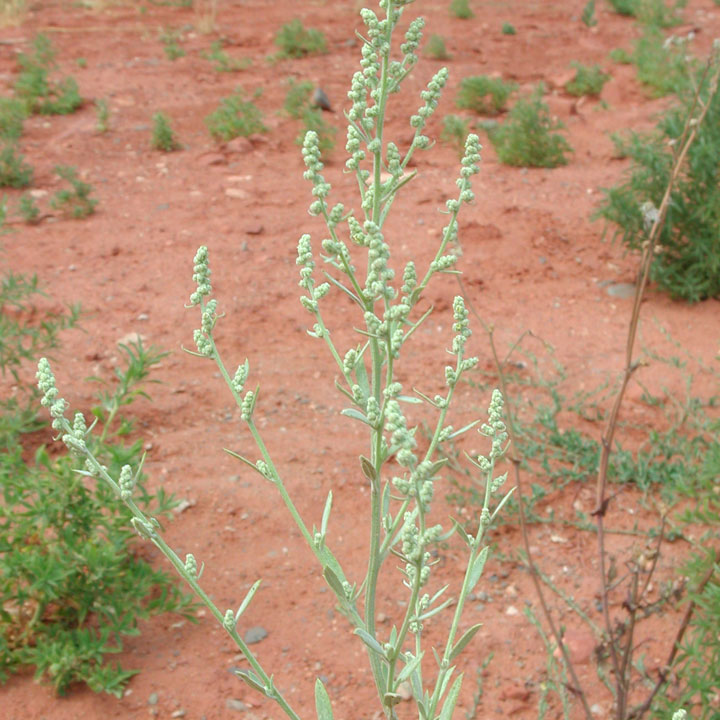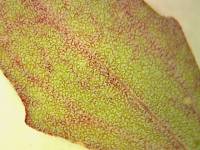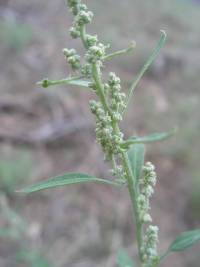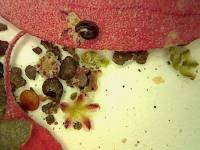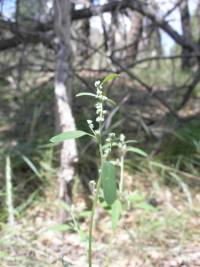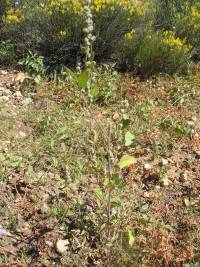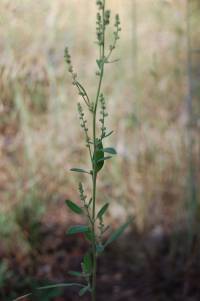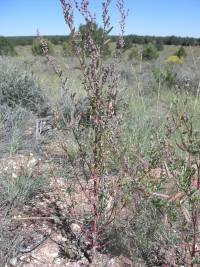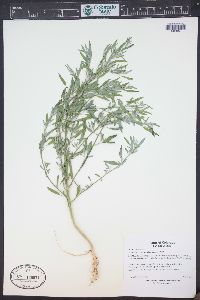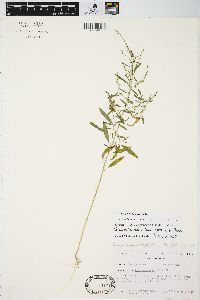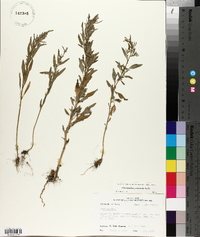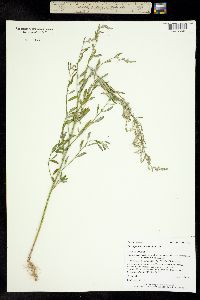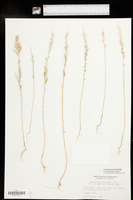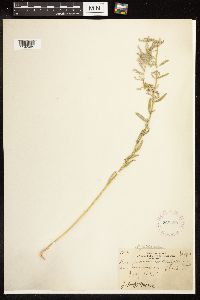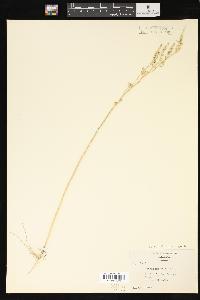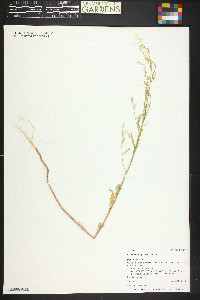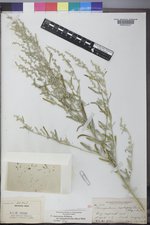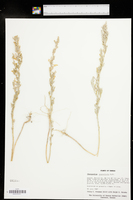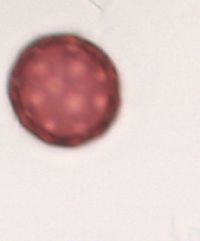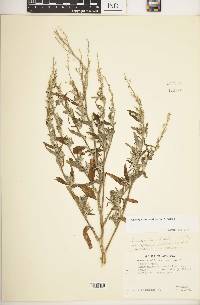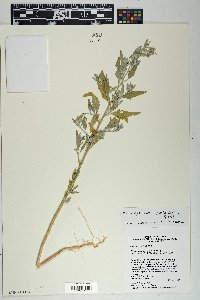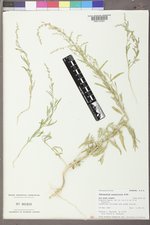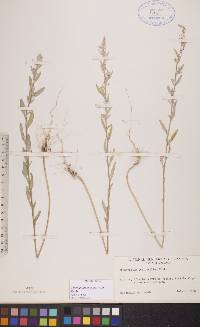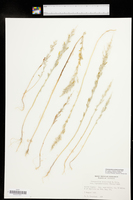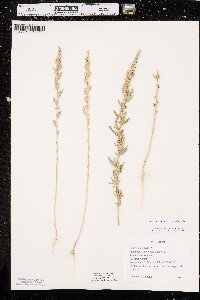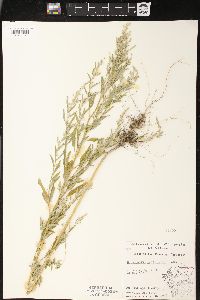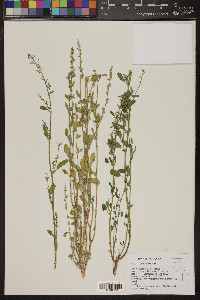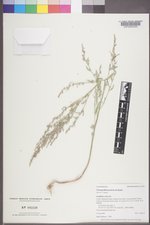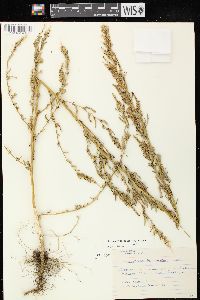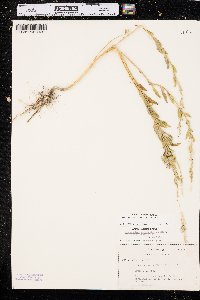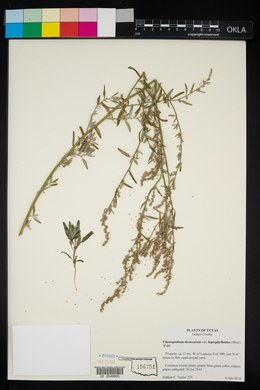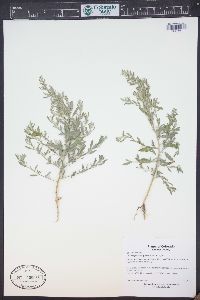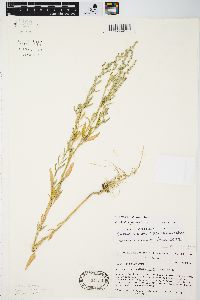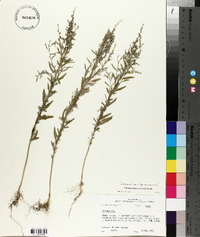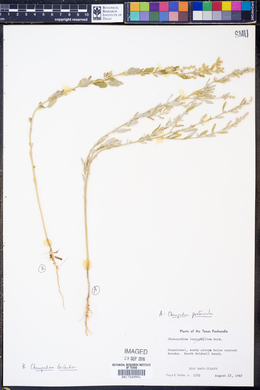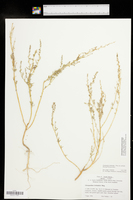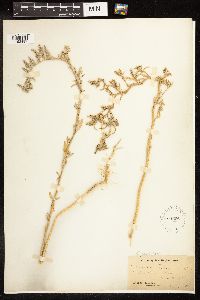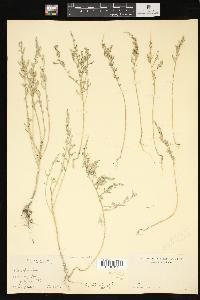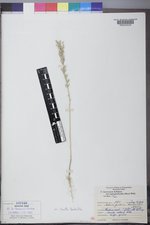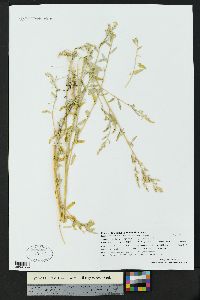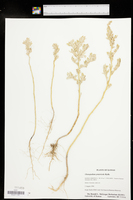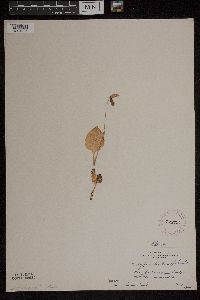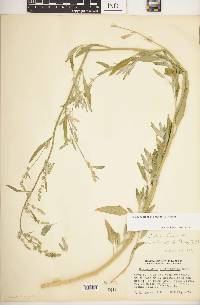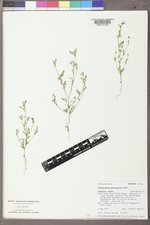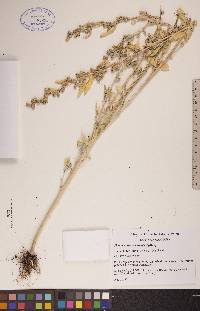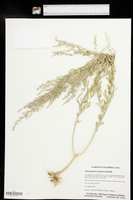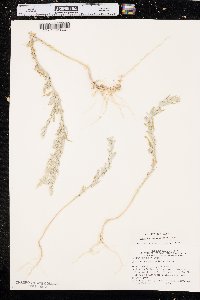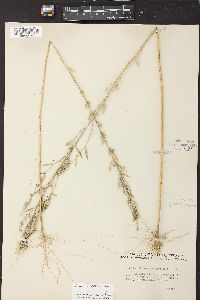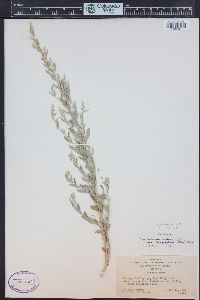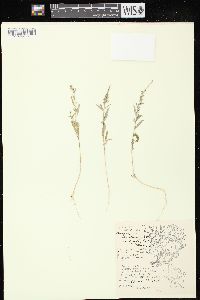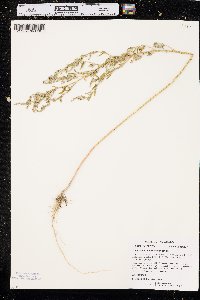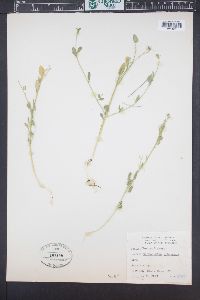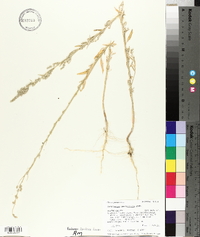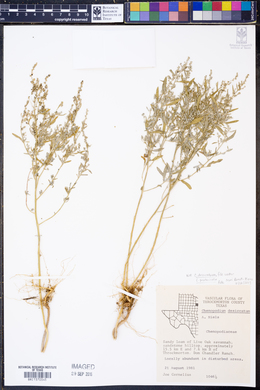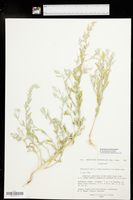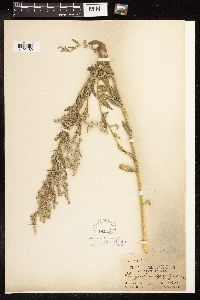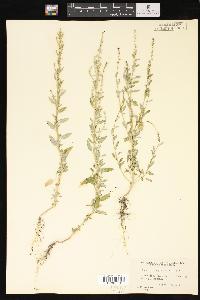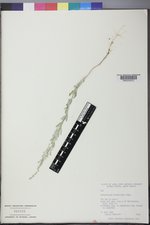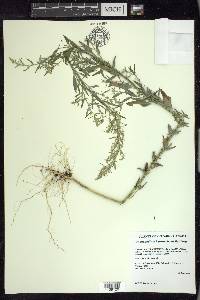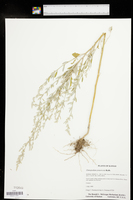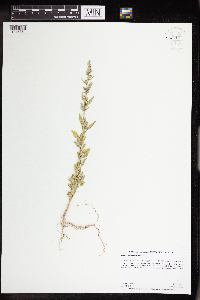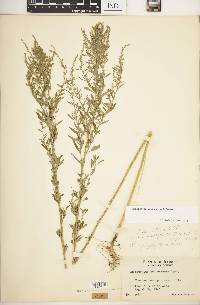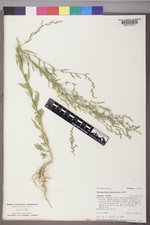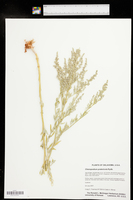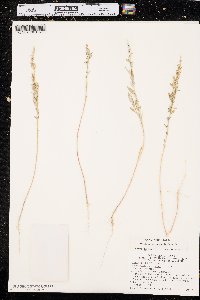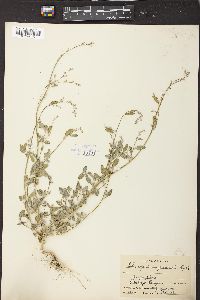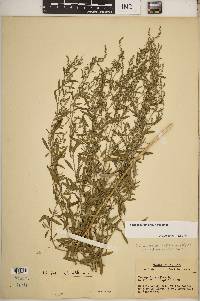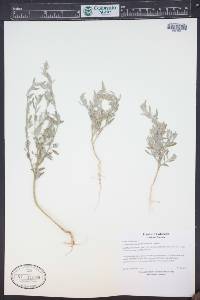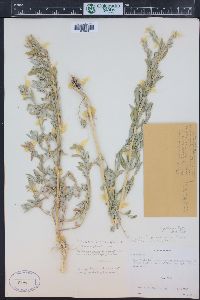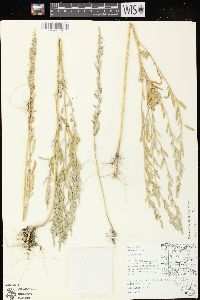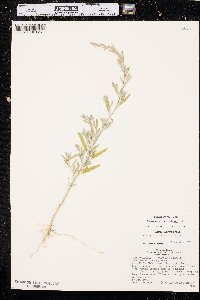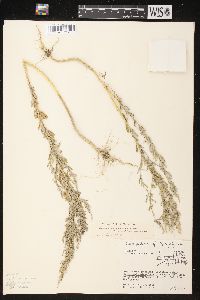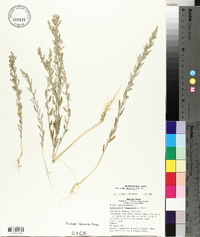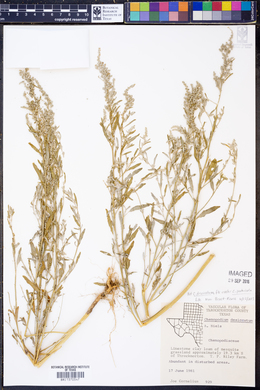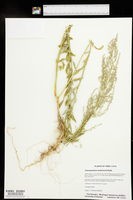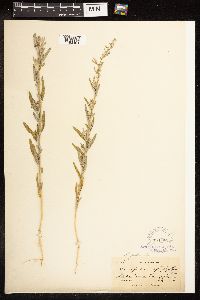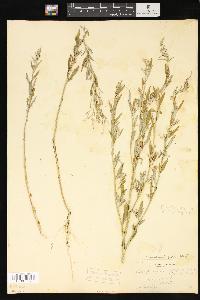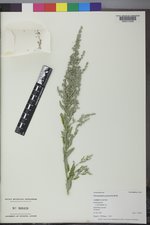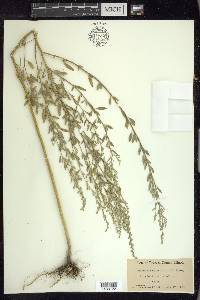Chenopodium pratericola
|
|
|
|
Family: Amaranthaceae
Desert Goosefoot
[Chenopodium desiccatum var. leptophylloides (J. Murr) H.A. Wahl, moreChenopodium pratericola subsp. eupratericola Aellen, Chenopodium pratericola var. leptophylloides (J. Murr) Aellen] |
Stems strictly erect, simple or branching above, 2-8 dm, moderately to densely farinose. Leaves nonaromatic; petiole 0.4-1 cm; blade linear to narrowly lanceolate, or oblong-elliptic, (1- or)3-veined, 1.5-4.2(-6) × 0.4-1(-1.4) cm, thick and somewhat fleshy, base cuneate, margins entire or with pair of lobes near base, apex acute, abaxial surface densely to sparingly white-mealy. Inflorescences glomerules in terminal and axillary panicles, 1-13 × 0.15-0.5 cm; glomerules usually densely disposed, maturing irregularly; bracts leaflike. Flowers: perianth segments (4-)5, distinct nearly to base; lobes oblong-ovate, 0.8-1 × 0.5-0.7 mm, apex obtuse, rounded or emarginate, strongly keeled along midvein, densely farinose, usually spreading from fruit; stamens (4-)5; stigmas 2, 0.2 mm. Utricles ovoid; pericarp nonadherent, smooth. Seeds round, 0.9-1.3 mm diam., margins rounded; seed coat black, rugulate. 2n = 18. Fruiting early summer-fall. Open sandy soils, pinyon woodlands, sagebrush, often in saline or alkaline habitats; 0-2400 m; Alta., B.C., Man., N.W.T., Ont., Sask., Yukon; Alaska, Ariz., Calif., Colo., Conn., Idaho, Ill., Ind., Iowa, Kans., Ky., La., Maine, Md., Mass., Minn., Mo., Mont., Nebr., Nev., N.H., N.J., N.Mex., N.Y., N.C., N.Dak., Okla., Oreg., Pa., R.I., S.C., S.Dak., Tex., Utah, Vt., Va., Wash., Wis., Wyo. Annual herb 20 cm - 0.8 m tall Stem: upright, unbranched to branched above, moderately to densely white-mealy. Leaves: alternate, upright to ascending, on a 0.4 - 1 cm long stalk, 1.5 - 4 cm long, 0.4 - 1.5 cm wide, linear to narrowly lance-shaped to narrowly egg-shaped with a tapering base and pointed tip, typically three-veined, sometimes with a pair of basal lobes, thick, somewhat fleshy, sparsely to densely white-mealy beneath. Inflorescence: a small, dense cluster of flowers (glomerule), which together form upright or ascending spikes, of which form a larger inflorescence (panicle), white-mealy. Flowers: greenish, small, with five nearly distinct sepals and no petals. Sepal lobes to 1 mm long, oblong egg-shaped with a blunt, rounded, or shallowly notched apex, prominently keeled along midvein, densely white-mealy. Stamens five. Stigmas two. Fruit: one-seeded (utricle), surrounded by the persistent, spreading sepals, egg-shaped, thin-walled. Wall (pericarp) loose and easily separable from the seed. Seed horizontal, black, shiny, 1 - 1.4 mm wide, spherical, round-margined, wrinkled. Similar species: No information at this time. Flowering: June to October Habitat and ecology: Black Oak savannas, railroad ballast, and sandy waste ground. Occurence in the Chicago region: native Etymology: Chenopodium comes from the Greek words chen, meaning goose, and podion, meaning "little foot," referring to the leaf shape of some species. Author: The Morton Arboretum Duration: Annual Nativity: Native Lifeform: Forb/Herb General: Strictly erect stems, simple or branching above, 20-80 cm tall, moderately to densely farinose. Leaves: Petiole 0.4-1 cm, blade linear to narrowly lanceolate, or oblong-elliptic, 3-veined, 1.5-4.2 cm by 0.4-1 cm, thick and somewhat fleshy, cuneate base, margins entire or with pair of lobes near base, apex acute, abaxial surface densely to sparingly white-mealy. Flowers: Glomerules in terminal and axillary panicles, 1-13 cm by 0.15-0.5 cm; densely disposed, maturing irregularly, bracts leaflike; perianth segments 5, distinct nearly to base, lobes oblong-ovate, 0.8-1 mm by 0.5-0.7 mm, apex obtuse, rounded or emarginated, strongly keeled along midvein, densely farinose, usually spreading from fruit; stamens 5, stigmas 2. Fruits: Ovoid utricles, pericarp nonadherent, smooth; round seeds, black, 0.9-1.3 mm diameter, rounded margins. Ecology: Open sandy soils, often in saline or alkaline places from sea level to 8,000 ft (2438 m); flowers May-September. Ethnobotany: Leaves boiled and eaten by the Gila Pima. Etymology: Chenopodium means goose foot, pratericola is from Latin partum, a meadow, meaning it dwells in meadows. Synonyms: Chenopodium albescens, Chenopodium pratericola subsp. eupratericola, Chenopodium pratericola var. leptophylloides Editor: SBuckley, 2010 Erect annual to 8 dm with ascending branches; lvs erect or ascending, oblong to lanceolate or lance-ovate, entire or the larger ones often few-toothed or subhastate, at least the larger ones 3-nerved from the base, but without any apparent secondary veins, mostly 2-4 cm נ4-15 mm, 3-5 times as long as wide; infl white-mealy, of many small glomerules in short, terminal or subterminal, erect or ascending spikes, forming a slender paniculiform infl; sep 5, carinate when ripe, tending to spread and expose the fr; pericarp loose, freely separable from the seed; seeds horizontal, black and shining, mostly 1.0-1.4 mm wide; 2n=18. In dry, open places in w. and c. U.S., and extending e. in woodlands to the Appalachian region and s. Que. (C. foggii; C. desiccatum var. leptophylloides, misapplied) Gleason, Henry A. & Cronquist, Arthur J. 1991. Manual of vascular plants of northeastern United States and adjacent Canada. lxxv + 910 pp. ©The New York Botanical Garden. All rights reserved. Used by permission. From Flora of Indiana (1940) by Charles C. Deam Widely distributed west of the Mississippi River, eastward probably only introduced. Highly polymorphic. Found usually in sandy soil. ...... Indiana Coefficient of Conservatism: C = 3 Wetland Indicator Status: UPL Diagnostic Traits: leaves mostly lance-linear, up. to 8 mm wide, farinose beneath; flowers in densely arranged glomerules; sepals 5, farinose; fruits horizontal; seeds 0.9-1.3 mm wide, cross-wrinkled. |
|
|
|

